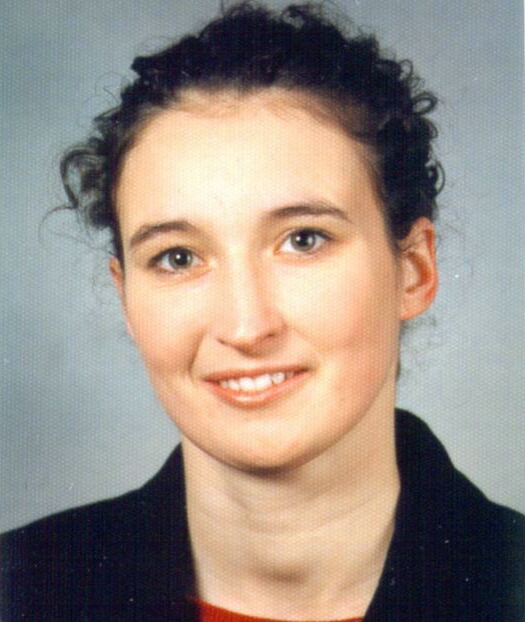Ramona Hoffmann
Ramona Hoffmann
- 2005 Dipl.-Ing. in Mechanical Engineering, University of Kaiserslautern
- 2005 – 2008 Corporate Sector Research and Advanced Engineering, Applied Research Microsystem Technologies, Robert Bosch GmbH Stuttgart
- 2008 – 2009 Production engineer in the international manufacturing network for Common Rail Injector CV, Robert Bosch GmbH Homburg
- 2009 – 2011 Doctoral candidate, Computational Dynamics and Control, University of Kaiserslautern
- 2011 – 2013 Doctoral candidate, Chair of Applied Dynamics, Friedrich-Alexander-Universität Erlangen-Nürnberg
- 2014 Dr.-Ing. Friedrich-Alexander-Universität Erlangen-Nürnberg
- 2013 – 2015 Scientific employee, Fraunhofer ITWM, Kaiserslautern
- 2015 – 2016 Scientific employee, Institute of Applied Dynamics, Friedrich-Alexander-Universität Erlangen-Nürnberg
- 2022 – Professor at HTW Saar
theses
2014
- :
Biomechanics and optimal control simulations of the human upper extremity (Dissertation, 2014)
reviewed journal publications
2019
- , , , , :
On optical data-guided optimal control simulations of human motion
In: Multibody System Dynamics (2019), p. 1-22
ISSN: 1384-5640
DOI: 10.1007/s11044-019-09701-4
2013
- , :
Biomechanical optimal control of human arm motion
In: Proceedings of the Institution of Mechanical Engineers Part K-Journal of Multi-Body Dynamics 227 (2013), p. 375-389
ISSN: 1464-4193
DOI: 10.1177/1464419313488363
2011
- , , :
On the relevance of structure preservation to simulations of muscle actuated movements
In: Biomechanics and modeling in mechanobiology Volume 11 (2011), p. 543-556
ISSN: 1617-7940
DOI: 10.1007/s10237-011-0332-0
conferences and proceedings
2023
- , , , :
Gender differences in cycling motions: On objective functions for urban cycling
GAMM Annual Meeting
In: Procc. App. Math. Mech. (PAMM) 2023
DOI: 10.1002/pamm.202300202
2016
- , , , , :
On data-guided optimal control simulation of human motion
GAMM Annual Meeting (Braunschweig, 2016-03-07 - 2016-03-11)
In: Proc. Appl. Math. Mech. (PAMM) 2016
DOI: 10.1002/pamm.201610016
2013
- , :
Dynamics of muscle paths in biomechanical simulations
GAMM Annual Meeting (Novi Sad, 2013-03-18 - 2013-03-22)
In: Proc. Appl. Math. Mech (PAMM) 2013
DOI: 10.1002/pamm.201310021 - , :
Muscle paths in biomechanical multibody simulations
ECCOMAS Thematic Conference on Mutlibody Dynamics (Zagreb, 2013-07-01 - 2013-07-04)
In: Proceedings of the ECCOMAS Thematic Conference on Mutlibody Dynamics 2013
2012
- , :
Optimal control of biomechanical motion using physiologically motivated cost functions
2nd Joint International Conference on Multibody System Dynamics (Stuttgart, 2012-05-29 - 2012-06-01)
In: Proceedings of the 2nd Joint International Conference on Multibody System Dynamics 2012 - , :
Optimal control simulations of human arm motion
GAMM Annual Meeting (Darmstadt, 2012-03-26 - 2012-06-30)
In: Proc. Appl. Math. Mech (PAMM) 2012
DOI: 10.1002/pamm.201210041
2011
- , , :
Optimisation and optimal control of multibody dynamics
EUROMECH Colloquium 522 (Erlangen, 2011-08-10 - 2011-08-13)
In: Recent Trends in Optimisation for Computational Solid Mechanics 2011 - , , :
Structure preserving optimal control of finger movements
Proceedings of the EUROMECH Colloquium 511 on Biomechanics of Human Motion (Ponta Delgada, Azores, 2012-03-09 - 2012-03-12)
In: Proceedings of the Euromech Colloquium 511 on Biomechanics of Human Motion, DVD, 16 pages 2011 - , , :
Structure preserving simulation of muscle actuated movements
GAMM Annual Meeting (Graz, 2011-04-18 - 2011-04-21)
In: Proc. Appl. Math. Mech (PAMM) 2011
DOI: 10.1002/pamm.201110042
further publications
-
Simulation and optimal control of the dynamics of multibody systems in biomechanics and robotics
(Third Party Funds Single)
Term: 2008-12-01 - 2011-12-01
Funding source: DFG-Einzelförderung / Emmy-Noether-Programm (EIN-ENP)Simulation is of great importance when studying everyday or athletic motions with regard to improvements in ergonomics and performance. In particular for medical problems like analysing gait or optimising prostheses as well as for planning robot manoeuvres, simulation is often the only way to estimate the actuating and applied forces and torques. An approximate solution can only be as accurate as the underlying numerical method represents the system’s characteristic properties. If, for example, the energy required to perform a motion is a criterion of interest, the use of an energy consistent method is crucial. In purely forward dynamical simulations, here mechanical integrators are widely accepted. This project aims to develop and investigate new efficient and robust methods for the dynamic optimisation of movements that guarantee the inheritance of the real solution’s relevant properties by the approximated solution. The developed methods are applied to varying fields. Multirate integrators are developed that simulate different system parts with individual time steps saving computational time while accuracy remains unchanged. To realistically simulate motions of the human arm, Hill-type muscle models actuate the limbs. A semi-analytic algorithm approximating the muscle path allows its use in optimal control problems with physiologically motivated cost functions. Everyday motions like operating a steering wheel or lifting a weight, as well as sports motions like long throw and shot put, are optimised. Another main point is the simulation of the lower extremities. The modelled limbs are actuated by joint torques and contact problems where inelasticities and friction are taken into account. Monopedal jumping and human gait are investigated. Changing between open and closed kinematic loops (double stance phase versus swing phase) is described by different holonomic constraints that are active or passive in different phases. For the example of optimising a pole vault, the introduced method is applied to a flexible multibody system. It is shown that the developed methods are very effective and flexible and therefore a variety of problems can be investigated ranging from robotics over everyday human motion to athletics’ high performance motions.

